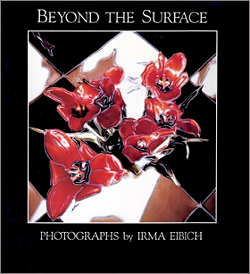1988 – Beyond the Surface
Photographs by Irma Eibich
The history of color photography can be considered as a long process of trial and error, punctuated at intervals by the invention of new materials which have made possible new ways of seeing and recording. In recent years one of the most significant advances in color has occurred in the realm of the instant image; Polaroid SX-70 film in particular, with its unique characteristics, has offered a genuinely new creative outlet for many contemporary photographers. This volume of photographs by Irma Eibich shows to good advantage what can be accomplished with this remarkable photographic system.
The flower still lifes that follow are brilliantly alive with color, creating a vibrant impression from the first viewing. The sense of balance and proportion conveyed by the square format contrasts pleasingly with the variety of formal approaches and color relationships displayed within the frame, and the sheer visual energy of the photographs is carefully modulated by the skillful use of a classic compositional reference. The images are thus formally resolved, in the traditional sense of still life, and yet highly abstracted, almost visionary, in their free use of contrasting visual elements.
The bold use of color as a carrier of expressive meaning adds to the abstract and imaginative aspects of this work. Color is used to record, to reveal, to express, and also to transform both the flowers and the space in which they exist. The transformation is made complete by the photographer’s re-working of the images, using heat and pressure to modify the photograph while the emulsion is still capable of being manipulated.
Because these are photographs, we accept and interpret them as real representations of what was before the camera; but because they are realized through a transformative process, they also present a new reality, apart from the element of time always associated with a literal rendition. The pictures offer themselves for extended contemplation, creating their own sense of time and space, using photographic means as a point of departure for the realization of an inner vision. What is explored through this vision is universal, connecting the natural world with the human imagination, the camera’s recording capacity with the artist’s expressive concerns, and the viewer’s perceptual responses with an evocative series of dream-like, yet absolutely real, images.

